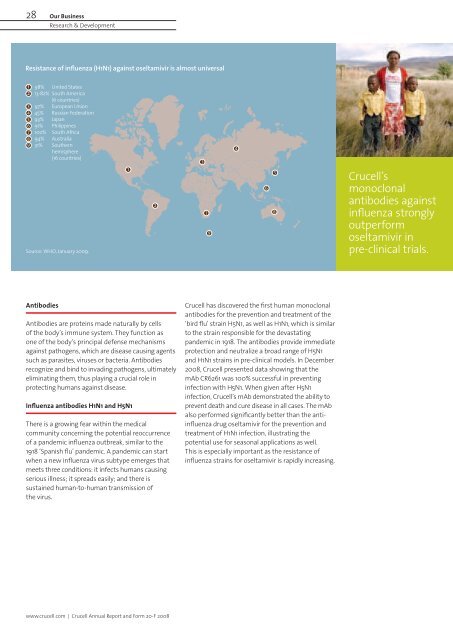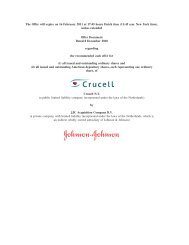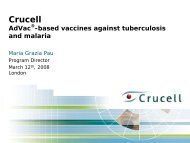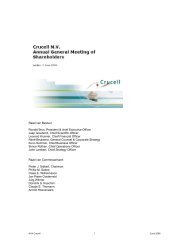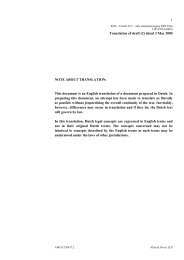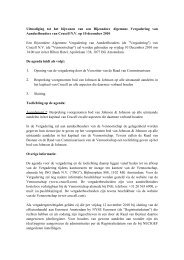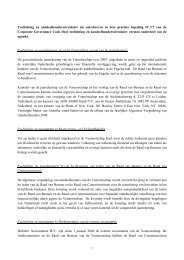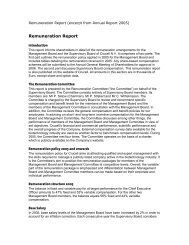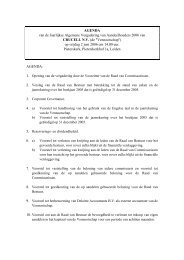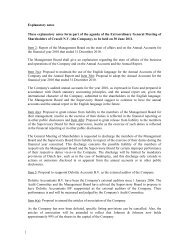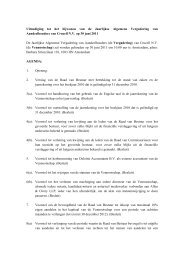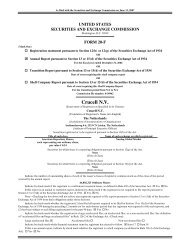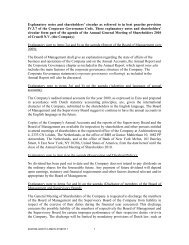Crucell 2008 Combating Infectious Diseases
Crucell 2008 Combating Infectious Diseases
Crucell 2008 Combating Infectious Diseases
You also want an ePaper? Increase the reach of your titles
YUMPU automatically turns print PDFs into web optimized ePapers that Google loves.
28 Our Business<br />
Research & Development<br />
Our Business 29<br />
Research & Development<br />
Resistance of influenza (H1N1) against oseltamivir is almost universal<br />
1 98% United States<br />
2 13-82% South America<br />
(6 countries)<br />
3 97% European Union<br />
4 45% Russian Federation<br />
5 93% Japan<br />
6 91% Philippines<br />
7 10o% South Africa<br />
8 94% Australia<br />
9 31% Southern<br />
hemisphere<br />
(16 countries)<br />
Source: WHO, January 2009.<br />
1<br />
2<br />
3<br />
7<br />
9<br />
4<br />
6<br />
5<br />
8<br />
<strong>Crucell</strong>’s<br />
monoclonal<br />
antibodies against<br />
influenza strongly<br />
outperform<br />
oseltamivir in<br />
pre-clinical trials.<br />
Rabies causes over 50,000 deaths each year in endemic countries<br />
Africa 24,000<br />
India 20,000<br />
China 2,500 and up<br />
Other Asia 8,900<br />
Source: FX Meslin, WHO<br />
NECTM, KNobel and<br />
Tang et al EID, 2005;<br />
Zhang et al InFoRab<br />
2005, APCRI data.<br />
In Asia and Africa,<br />
where an estimated<br />
40,000 to 70,000<br />
people die from<br />
rabies each year,<br />
there is a significant<br />
unmet medical<br />
need for a safe,<br />
effective and<br />
affordable<br />
treatment.<br />
Antibodies<br />
Antibodies are proteins made naturally by cells<br />
of the body’s immune system. They function as<br />
one of the body’s principal defense mechanisms<br />
against pathogens, which are disease causing agents<br />
such as parasites, viruses or bacteria. Antibodies<br />
recognize and bind to invading pathogens, ultimately<br />
eliminating them, thus playing a crucial role in<br />
protecting humans against disease.<br />
Influenza antibodies H1N1 and H5N1<br />
There is a growing fear within the medical<br />
community concerning the potential reoccurrence<br />
of a pandemic influenza outbreak, similar to the<br />
1918 ‘Spanish flu’ pandemic. A pandemic can start<br />
when a new influenza virus subtype emerges that<br />
meets three conditions: it infects humans causing<br />
serious illness; it spreads easily; and there is<br />
sustained human-to-human transmission of<br />
the virus.<br />
<strong>Crucell</strong> has discovered the first human monoclonal<br />
antibodies for the prevention and treatment of the<br />
‘bird flu’ strain H5N1, as well as H1N1, which is similar<br />
to the strain responsible for the devastating<br />
pandemic in 1918. The antibodies provide immediate<br />
protection and neutralize a broad range of H5N1<br />
and H1N1 strains in pre-clinical models. In December<br />
<strong>2008</strong>, <strong>Crucell</strong> presented data showing that the<br />
mAb CR6261 was 100% successful in preventing<br />
infection with H5N1. When given after H5N1<br />
infection, <strong>Crucell</strong>’s mAb demonstrated the ability to<br />
prevent death and cure disease in all cases. The mAb<br />
also performed significantly better than the antiinfluenza<br />
drug oseltamivir for the prevention and<br />
treatment of H1N1 infection, illustrating the<br />
potential use for seasonal applications as well.<br />
This is especially important as the resistance of<br />
influenza strains for oseltamivir is rapidly increasing.<br />
Rabies Antibody Combination<br />
Globally, around 10 million people a year are treated<br />
after exposure to rabies virus. Nevertheless, between<br />
40,000 and 70,000 people die of rabies each year,<br />
mainly in Africa, China and India. This highlights<br />
the significant unmet medical need for a safe,<br />
effective and affordable rabies treatment. The<br />
approach currently used to prevent symptomatic<br />
disease and death in people exposed to rabies virus<br />
combines immunoglobulins (antibodies prepared<br />
from human or equine blood) with the vaccine.<br />
Concerns about the safety and availability of bloodderived<br />
rabies antibodies have prompted the search<br />
for alternatives.<br />
Using MAbstract ® and PER.C6 ® technology,<br />
<strong>Crucell</strong> scientists in collaboration with the<br />
Thomas Jefferson University in Philadelphia and<br />
the US Centers for Disease Control and Prevention<br />
in Atlanta have discovered a combination of human<br />
monoclonal antibodies (mAbs) for the postexposure<br />
treatment of rabies. Clinical testing of this<br />
mAb combination made good progress during <strong>2008</strong>,<br />
leading to the presentation in October of very<br />
promising efficacy and safety data from a Phase II<br />
trial in the USA. In order to test the mAb<br />
combination in different populations and settings,<br />
additional Phase II trials were started in May <strong>2008</strong><br />
(among children in the Philippines) and February<br />
2009 (among adults in India).<br />
Since January <strong>2008</strong>, the route towards global<br />
availability of this next-generation, life-saving rabies<br />
biological is being facilitated by <strong>Crucell</strong>’s strategic<br />
partnership with sanofi pasteur, a world leader<br />
in rabies immunization. The US Food and Drug<br />
Administration (FDA) has granted <strong>Crucell</strong>’s mAb<br />
combination Fast Track status, which paves the<br />
way for priority handling of the regulatory dossier.<br />
www.crucell.com | <strong>Crucell</strong> Annual Report and Form 20-F <strong>2008</strong> www.crucell.com | <strong>Crucell</strong> Annual Report and Form 20-F <strong>2008</strong>


